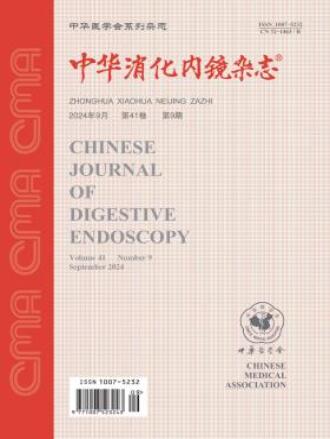人工智能胃镜在盲区监测和独立图像采集中的应用
引用次数: 1
摘要
目的分析实时胃镜监测系统(gastroscopic elf)在胃镜检查中的盲区监测和独立图像采集功能。方法收集武汉大学人民医院消化内镜中心数据库中的38 522张胃镜图像,对胃镜检查人员进行训练和验证。利用计算机生成随机数,选取91个胃镜视频评估胃镜精灵的位置识别准确性,选取内镜医师采集的45个胃镜视频和匹配的胃镜图像,比较胃镜精灵与内镜医师图像采集的胃镜位置覆盖率和胃镜位置覆盖率。两名内窥镜医师进入研究,分别使用或不使用胃镜进行胃镜检查。收集A内镜医师在使用胃镜精灵前后分别进行的胃镜检查45例,同时收集B内镜医师同期未使用胃镜精灵进行的胃镜检查42例,分为20例和22例。比较两种内镜医师胃镜检查部位的覆盖率。结果胃镜下机器人的总位置识别准确率为85.125%(1 156/1 358)。A内镜医师使用胃镜前后胃镜部位覆盖率分别为(76.790±8.848)%和(87.325±7.065)%,B内镜医师同期胃镜部位覆盖率分别为(75.926±11.565)%和(75.253±14.662)%。两种内镜医师使用胃镜前的覆盖率差异无统计学意义(t=0.324, P=0.747)。内镜医师A在使用胃镜精灵后的覆盖率高于未使用胃镜精灵前(t=6.222, P=0.001),同期内镜医师B的覆盖率高于未使用胃镜精灵前(t ' =3.588, P=0.002)。胃镜和内镜影像采集的胃镜部位覆盖率分别为20.956±3.406和(77.613±12.613)%、15.467±2.296和(57.284±8.503)%,差异有统计学意义(t=11.523, P=0.000;t = 11.523, P = 0.000)。结论人工胃镜检查可提高胃镜检查部位的覆盖率和覆盖率,值得在临床推广。关键词:胃镜检查;人工智能;盲区监测;独立图像采集本文章由计算机程序翻译,如有差异,请以英文原文为准。
Application of artificial intelligence gastroscope in blind area monitoring and independent image acquisition
Objective
To analyze the blind area monitoring and independent image acquisition function of gastroscopic elves (a real-time gastroscopic monitoring system) in gastroscopy.
Methods
A total of 38 522 gastroscopic images from the database of Digestive Endoscopy Center of Renmin Hospital of Wuhan University were collected to train and validate the gastroscopic elves.Using computer to generate random numbers, 91 gastroscopic videos were selected to assess the position recognition accuracy of the gastroscopic elves, and 45 gastroscopic videos and matching gastroscopic images collected by endoscopists were selected to compare the coverage number and rate of gastroscopy sites between gastroscopic elves and endoscopists image acquisition. Two endoscopists entered the study to perform gastroscopies with or without gastroscopic elves. Forty-five gastroscopies respectively performed by the endoscopist A before and after usage of gastroscopic elves were collected, and 42 gastroscopies divided into 20 and 22 performed by the endoscopist B without use of gastroscopic elves in the same period were also collected. The coverage rate of gastroscopy sites was compared between the two endoscopists.
Results
The total position recognition accuracy of gastroscopic elves was 85.125% (1 156/1 358). The coverage rate of gastroscopic sites for the endoscopist A was (76.790±8.848)% and (87.325±7.065)%, respectively, before and after using gastroscopic elves, and the coverage rate in the same period for the endoscopist B was (75.926 ±11.565)% and (75.253 ±14.662)%, respectively. The coverage rate before using gastroscopic elves had no statistical difference between the two endoscopists (t=0.324, P=0.747). The coverage rate for the endoscopist A after using gastroscopic elves was higher than that before using gastroscopic elves (t=6.222, P=0.001), and that of the endoscopist B in the same period (t′=3.588, P=0.002). The coverage number and rate of gastroscopy sites for gastroscopic elves and endoscopists image acquisition were 20.956 ±3.406 and (77.613±12.613)%, and 15.467±2.296 and (57.284±8.503)%, respectively, with statistical differences (t=11.523, P=0.000; t=11.523, P=0.000).
Conclusion
Gastroscopic elves can improve the coverage number and rate of gastroscopy sites, and is worthy of promotion in clinics.
Key words:
Gastroscopy; Artificial intelligence; Blind area monitoring; Independent image acquisition
求助全文
通过发布文献求助,成功后即可免费获取论文全文。
去求助
来源期刊
CiteScore
0.10
自引率
0.00%
发文量
7555
期刊介绍:
Chinese Journal of Digestive Endoscopy is a high-level medical academic journal specializing in digestive endoscopy, which was renamed Chinese Journal of Digestive Endoscopy in August 1996 from Endoscopy.
Chinese Journal of Digestive Endoscopy mainly reports the leading scientific research results of esophagoscopy, gastroscopy, duodenoscopy, choledochoscopy, laparoscopy, colorectoscopy, small enteroscopy, sigmoidoscopy, etc. and the progress of their equipments and technologies at home and abroad, as well as the clinical diagnosis and treatment experience.
The main columns are: treatises, abstracts of treatises, clinical reports, technical exchanges, special case reports and endoscopic complications.
The target readers are digestive system diseases and digestive endoscopy workers who are engaged in medical treatment, teaching and scientific research.
Chinese Journal of Digestive Endoscopy has been indexed by ISTIC, PKU, CSAD, WPRIM.

 求助内容:
求助内容: 应助结果提醒方式:
应助结果提醒方式:


